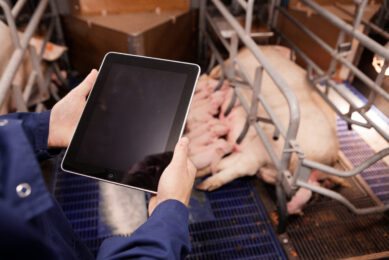Artificial intelligence: a new paradigm in the swine industry

An accurate estimation of pig body weight is essential to determine market-ready pigs and to reduce losses associated with the sorting process. Weighing pigs by running them through the scale provides the most accurate measurement of body weight. However, this is time-consuming, and it may cause injuries and stress in pigs. Artificial intelligence has gained tremendous attention to resolve challenges in intensive swine farming and to enhance productivity and efficiency in the swine industry by real-time data collection of feeding behaviour and feed intake.
Machine learning is one of the artificial intelligence models frequently used for modeling, prediction, and management of swine farming. Machine learning models mainly include algorithms of a decision tree, clustering, a support vector machine, and the Markov chain model focused on disease detection, behaviour recognition for postural classification, and sound detection of animals. The researchers from North Carolina State University and Smithfield Premium Genetics* demonstrated the application of machine learning algorithms to estimate body weight in growing pigs from feeding behaviour and feed intake data.
Data collection
Feed intake, feeder occupation time, and body weight information were collected from 655 pigs of 3 breeds (Duroc, Landrace, and Large White) from 75 to 166 days of age. 2 machine learning algorithms (long short-term memory network and random forest) were selected to forecast the body weight of pigs using 4 scenarios. Long short-term memory was used to accurately predict time series data due to its ability in learning and storing long term patterns in a sequence-dependent order and random forest approach was used as a representative algorithm in the machine learning space. The scenarios included an individually informed predictive scenario, an individually and group informed predictive scenario, a breed-specific individually and group informed predictive scenario, and a group informed predictive scenario. 4 models each implemented with 3 algorithms were constructed and trained by different subsets of data collected along the grow-finish period to predict the body weight of individuals or groups of pigs.
Predicting body weight from behaviour data
Overall, as pigs matured and gained weight, daily feed intake increased, while the daily number of visits and daily occupation time decreased. Overall, the individually informed predictive scenario achieved better predictive performances than the individually and group informed predictive scenarios in terms of correlation, accuracy, sensitivity, and specificity. The greatest correlation was 0.87, and the highest accuracy was 0.89 for the individually informed prediction, while they were 0.84 and 0.85 for the individually and group informed predictions, respectively. The effect of the addition of feeding behaviour and feed intake data varied across algorithms and scenarios from a small to moderate improvement in predictive performance.
Diverse predictive scenarios
This study demonstrated various roles of feeding behaviour and feed intake data in diverse predictive scenarios. The information collected from the period closest to the finishing stage was useful to achieve the best predictive performance across predictions. Artificial intelligence has the potential to connect feeding behaviour dynamics to body growth and to provide a promising picture of the feeding behaviour data involvement in the group-housed pigs’ body weight prediction. Artificial intelligence and machine learning can be used as management tools for swine farmers to evaluate and rank individual pigs to adjust feeding strategies during the growth period and to avoid sorting losses at the finishing stage while reducing labor and costs.
Challenges and future research needs
Some technologies and tools have been developed for data collection, data processing, and modeling algorithms to evaluate pigs feeding behaviour and feed intake. These technologies demonstrated great potential to enhance the swine industry efficiency on decision making. A standard database or method for data cleaning and selection is however required to minimise the time and costs of data processing.
* He Y, Tiezzi F, Howard J, Maltecca C. Predicting body weight in growing pigs from feeding behavior data using machine learning algorithms. Comput Electron Agric. 2021;184:106085. doi:10.1016/j.compag.2021.106085











